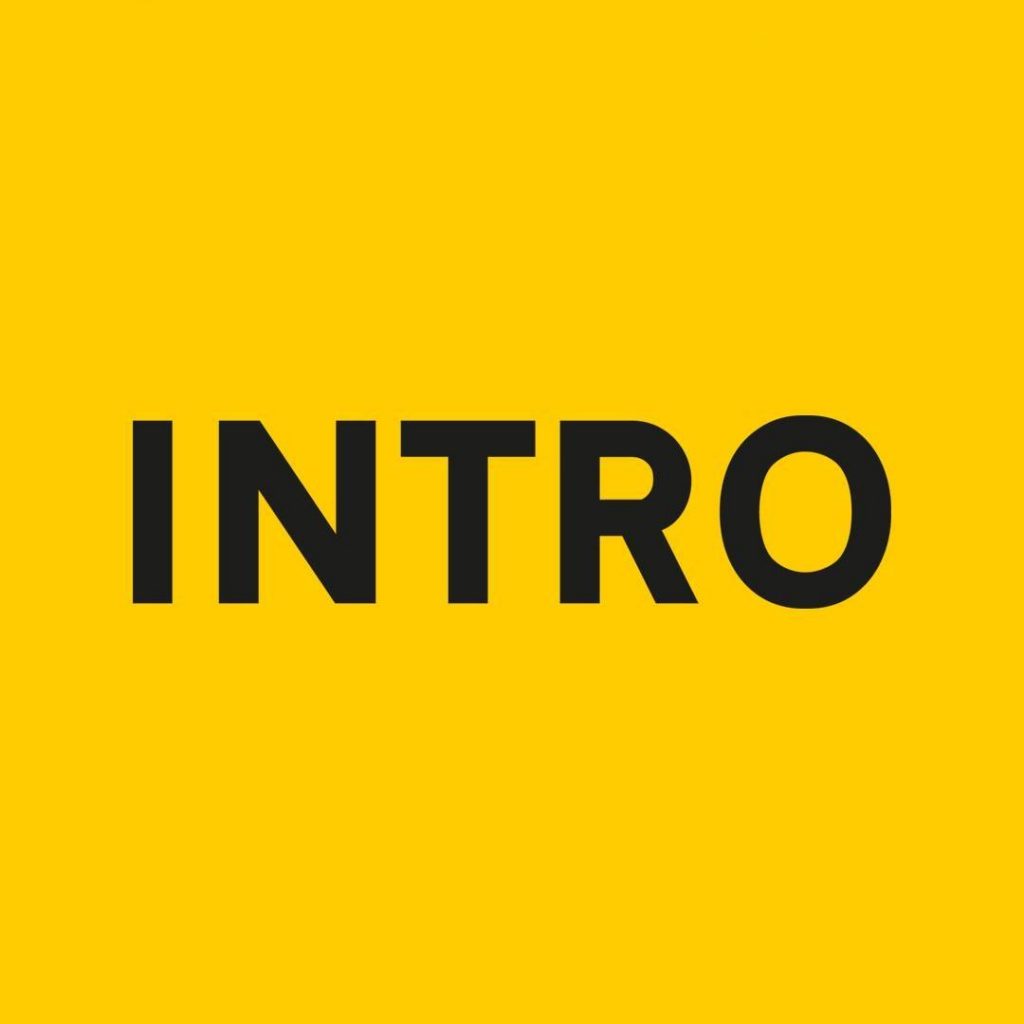

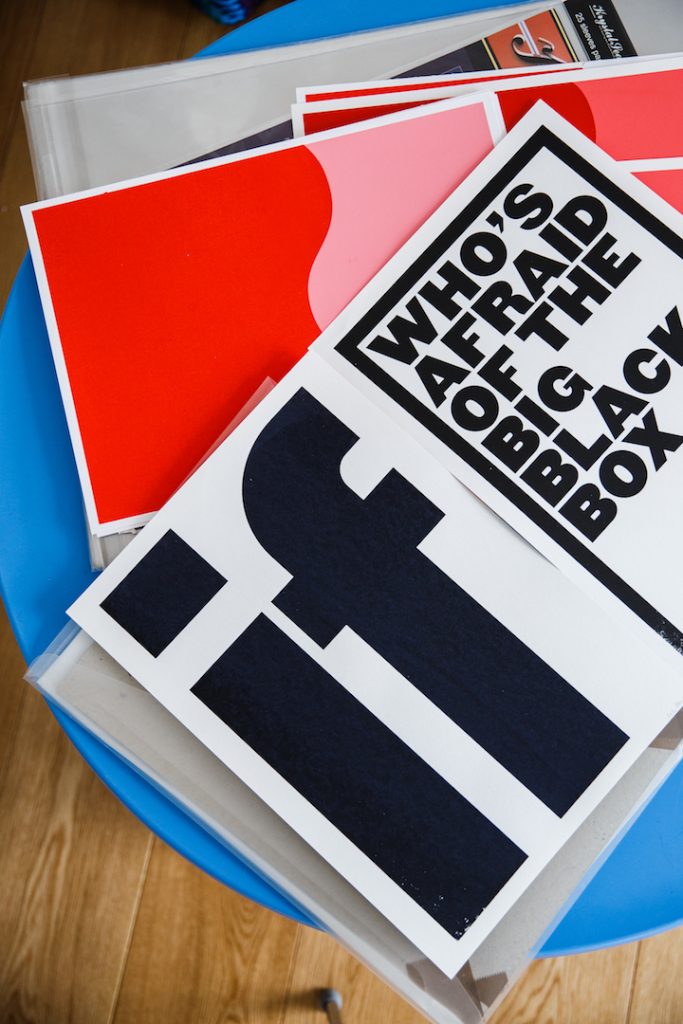
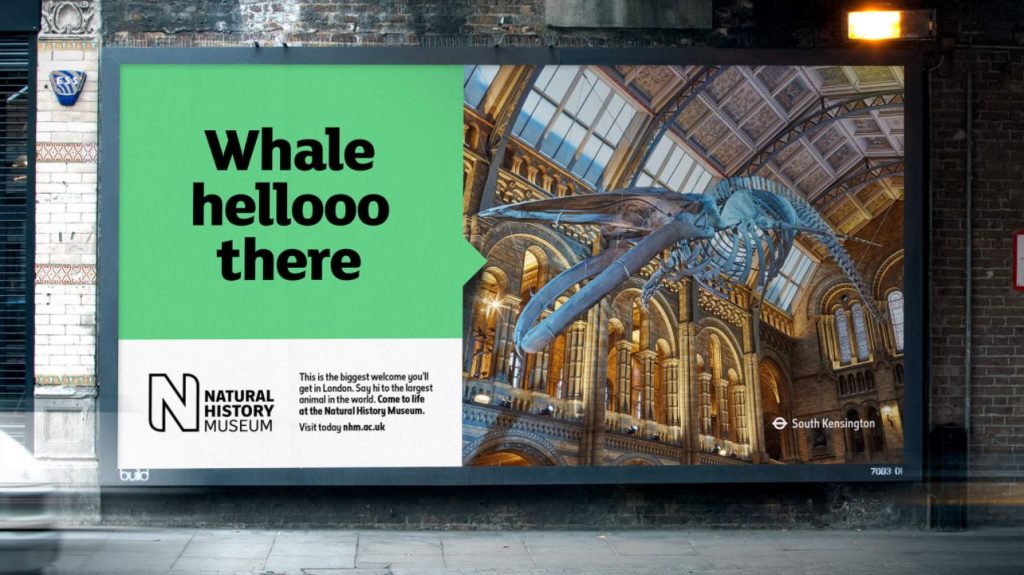
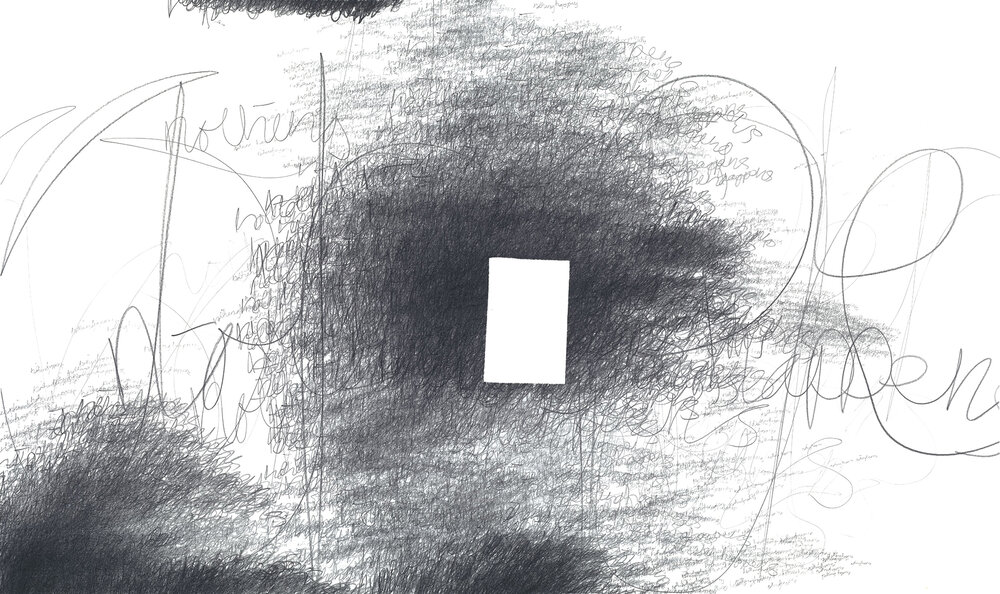
Practitioner Case Studies
Hi,
Week one, and we have been set the theme of identity and what that means for existing professionals as well as for me. The first part of this blog will examine five different studios and how their practices differ. By analysing their answers in terms four questions, who, what where and why, I hope to better understand my own identity and what makes me unique as a Graphic Designer.
Intro Design
Intro Design introduced us to two of their designers, Julian House and Adrian Talbot. Julian describes who he is by braking it down into three parts – where he is from, how long he has been with intro and what work he enjoys. For me, answering the question as Julian has, I was born in Wandsworth, London but moved to Great Yarmouth, Norfolk when I was 8 years old. This is the place I call home. Where I was educated, built a family and a career. In terms of my work, I enjoy a variety of design challenges but have to say brand creation is my favourite. Adrian sees himself as his job title as well as how long he has worked at Intro. I find it interesting how he compares himself directly to Julian saying, “I am more of a traditional graphic designer…and get a kick out of regular graphic design.” Regular graphic design would be difficult for me to identify. I often produce leaflets, logos, web graphics etc but I feel that the role of a Designer is so much more than this. It’s about providing a holistic communication solution to a client which works both on their level as well as the intended audience.
When the pair move onto talk about their work, they reduce it to a basic interest which developed into a passion and eventually a career. I suppose my story is the same as theirs, however, I would define my own practices based on other external factors. For example, I spent several years working in the police force and while that has nothing to do with design, it has everything to do with people. Without a good understanding of people, we cannot create successful, emotive and personal experiences for them. So yes, I do Graphic Design because it interested me when I was younger. But also, because it challenges me to understand people and society in a way which offers my design influence and impact. When the duo speak about Intro itself and how the company works they introduce the idea of a ‘design cooperative’ and while they have their own specialisms, they rarely collaborate on projects. Instead, they work on their own projects and if that it requires a different discipline they will pass the job onto their colleagues with little further interaction. I get this. It makes sense. Maybe that’s because I am the only designer at my current place of work and therefore must often work in isolation. I often feel that the involvement of others can hinder the design process or influence its outcome. Sometimes, however, its this collaborative approach which can fill in blanks and ultimately provide a cleaner more informed final piece.
“Design becomes a visual language in terms of all sorts of cultural reference points….” Julian House, Intro Design.
Julian goes onto talk about design being a visual language and how it takes on many referencing points and, ‘becomes a signpost for the identity’ and “what their cultural markers are.” I feel this is a nod to the holistic approach I discussed earlier but also shows that with every brief there is a pathway carved out through the various referencing points afford to us by the client.
Adrian describes Julian as an artist and is able to express this artistic talent through his designs. Artists create for themselves. Either like it, or don’t. They don’t often have briefs and clients but create items which come from within. I imagine being in artist is a true expression of identity and self as it is unhindered by anyone else’s eye apart from your own. If you can earn the respect and reputation to be this free in design, you are in an ideal situation. This is what I work to every day.
Adrian describes his own journey as, “…develop[ing] an interest in words and pictures and how they combine to tell a story” and being, “seduced by how it looked”, before growing as a designer and learning to tell the story first and then making it look good. I think everyone, in every creative field, has this same timeline. For example, take pop singers. How often have you listed to someone and heard someone else? The one that comes to mind is Bruno Mars and Michael Jackson. We all have our influences. It’s about taking that identity, learning from it, applying your own spin and becoming your own unique person or designer.
Change for these two is quite different from the change I have experienced in my own life. When asked about change you are going to look at the beginning of your career and where you are now. For these two that is a 20+ year window of change. The world has changed phenomenally in the last 20 years and the world of design is no different. I remember one of my first jobs was working at a local newspaper creating adverts. The owner would tell me about when the paper first started and had almost 100 people on its staff. He said this while I sat in a room with him and two others who were producing a monthly paper their own. This is solely down to technological improvements. I believe the best thing I can do to keep up with the ever-changing world of design is to see the developments as tools to help me convey the ‘story’ as efficiently and effectively as I can.
The lecture finishes with Adrian saying, “you can’t become a designer if you’re not inherently a designer”. While I agree that design comes from within and is a natural talent I also feel it is something which can be nurtured and developed in order to be the best you can be.
Sara Boris
Sara defines who she is in terms of her birth location, where she has lived and her studies. She also talks about being influenced and inspired by a variety of sources but mainly from, ‘people and the streets’. My own inspiration is drawn from the people around me, and I am fascinated but what makes a person tick. I believe that it is this understanding which allows me to create purposeful design solutions.
Working mainly in editorial design and branding, Sara uses her typographical skills and knowledge of people and environments to enhance her designs. When working with a theatre in France she “felt it was really important to respond to the space”. Working as a local authority Graphic Designer the environment, history and culture are so important to my work. With every piece I am taking into consideration all these factors before putting pen to paper. As an example, last year I was asked to create a brand for the historical Waterways. The colours, logo and tone of voice all have a basis in the attraction’s rich history.
“One of those happy design accidents” Sarah Boris
I love this idea of ‘happy accidents’. They have definitely happened to me over the years and I honestly believe that these aren’t accidents and rather they are things our brains have noticed and implemented but forgot to tell us. Sometimes it takes someone else to tell us or a different perspective. I remember a story I heard about the FedEx Logo and the hidden arrow being a ‘happy accident’. I imagine in reality, the ‘E’ and ‘X’ were put together and then someone noticed the arrow rather than the arrow being drawn ad the ‘E’ and ‘X’ made to fit.
Another designer based in London, Sara likes the buzz, exhibitions and being close to clients. I cannot help but think, that in the light of Covid-19, this closeness might change. Over the years more and more people work from home and have virtual meetings with clients. The current crisis has forced people to work more digitally and I believe this will become more of a norm moving forward.
Sara also talks about changing her practice depending on where she is geographically. To me, this sounds more about being responsive to the client or the brief and immersing you in that world. Could I design for a sports car company for example? Well, I have never designed for one before, but would immerse myself in their world – history, culture, location etc – to produce a poignant piece of design.
Regular Practice
The two newly grads, Kristoffer Soelling and Tom Finn, created Regular Practice just over a year ago and it feels as if they are still finding their feet in the Graphic Design marketplace. This venture for them is very important and defines them both when asked ‘who they are?’.
Like Julian House from Intro, Kristoffer describes a practice which focuses on an interest of theirs which heightens their passion. They describe their design work as being, “type-centric”, which I think will both focus and limit their clients. It’s certainly a noble approach in these economically tough times. My own current practice doesn’t afford me this luxury. Working for a local authority I have to be a jack of all trades and use a variety of design skills to complete my job. Having said that, I still have my passions and really enjoy logo design and planning out the juxtaposition of image and text.
The duo has chosen to base themselves in Hackney Wick, East London because it is convenient and affordable for them. They share the space with other creatives which further reduces the cost of living for them. It is this approach which further allows them the, “freedom to do the kind of work [they] want to do”.
Tom explains that he finds Graphic Design, “very rewarding”, and that he enjoys the fact there is a clear output at the end. “It’s very like A to B, and you know that there’s a tactile object at the end of it.” I too find this an extremely rewarding part of design. You start with nothing but a brief. After committing yourself fully to it and immersing yourself in the client’s world you end up creating a tangible design or concept. This feels me with a great sense of pride and satisfaction, and I think it’s the same for Regular Practice.
Further to the idea of becoming part of the world you are designing for Tom says, “I think if your practice isn’t changing on a very regular basis, then I think things start to get boring quite quickly.” It’s this variety that makes Design so exciting. How you approach design may not change, however, the realms you inhabit differ from job to job – A brief for an airline will require a completely different approach to a charity in the local area.
What is really refreshing about the discussion with Regular Practice is that they are not afraid of admitting they have made mistakes. Tom says, “some of [the projects] went really badly”. I think that no one will be able to complete a project seamlessly, and in fact, its these mistakes which allow you to grow as a designer. As Oscar Wilde once said, “Experience is simply the name we give our mistakes.”
Sam Winston
Sam is also a designer from London. He identifies very much so with his disability, dyslexia. Instead of this becoming a problem for him it became something which he explored and as he says, “made me who I am”. I suffer with anxiety and have done all my life. In my late teens I was also diagnosed with Obsessive Compulsive Disorder (OCD) relating to anxiety. When I am not anxious the OCD has little to no effect on my life. When I am anxious it can be quite troublesome, however, I have learnt to ways in which to deal with it. I believe that the OCD has always had an influence on my life. I like things to feel right and I suppose design is all about things being in the ‘right’ place to look good.
Sam is quite unique in his style as he likes writing as well the intricacies of typography. He started his career by looking for employment as a Graphic Designer but soon realised that his style was a little limited in its applications. Rather than be employed as a Graphic Designer Sam decided to look for clients and apply what he loves to their briefs.
Based in a self-contained unit in London he enjoys the silence it brings. In fact, its something he needs due to the “intense environment” that the capital brings. While he toys with the idea of moving out of London he sees it as an inspirational environment to be in. He says, “it is intensive, it’s culturally rich, it’s diverse, like rich compost”. But this needs to be balance with the silence of his studio. Where I am based the environment is nowhere near as culturally rich and diverse as London but does have a rich heritage which means I have an exceptional historical resource to delve in and out of. I wonder if there is a way to experience culturally rich and intense environments digitally?
I absolutely agree and love the idea Sam proposes, “If you treat design as a noun, it’s a thing that’s solid and it’s what you do, I’m a ‘designer’”. This to me suggests a much more holistic approach to design in that while you are mainly involved in creating a final designed piece, you are also thinking about the bigger picture and how other creatives and ideas can feed into your idea to improve the experience.
In terms of his practice and how it changes he has two main theories. Firstly, he tends to avoid change as it happens and tries to focus on what he knows to ensure he gets paid and still has a job. Secondly, he tries to design concepts rather than physical final pieces first and foremost. This protects him from negative change. He says,” if I’ve got this fluidity to the project itself, I’m like, well it never really was a poster, in the fact that the idea is about like language and storytelling”.
Sam clearly has compartmentalised his life to help him deal with the constant changes in his life. He has a studio which is ‘his space’. It is the place he works he keeps it constrained He says, “my working day is from nine and it finishes at 6:30, so I will work on that problem till then and then I will drop it and I’ll go home.” I too feel its good to have these divides in place. I am not just a Designer. I am a student, a father, a taxi driver, a husband, a friend, a gamer and DIY’er. Everyone is spinning lots of plates and it’s better to spin one at a time rather than keeping them all in the air.
Of course, by working on his own, Sam is responsible for a lot more than just designing. He says, “. I joke, and it’s part joke but part true, but I never thought I needed to know Excel or write a good PDF”. He says, “you don’t have to. But the person who can be bothered to deal with it will be your boss.” If you learn to deal with these things it can buy you the freedom to be who you want to be. I have some of these responsibilities but still have a boss to answer to. I think the main reason for that is there are lots of strategic decisions happening in the background which I could not possibly be aware of and do my job. There just isn’t enough time! So while I agree with Sam that working on your own buys you some freedom I also think that it only buys you freedoms within your own capabilities and if you want to expand past these you will either need a boss , a trusted set of employees or work with collaborators. Looking back to Intro design, both Julian House and Adrian Talbot worked within their specialisms but had a MD who oversaw the general activity of the business.
Someone
Simon Manchipp runs SomeOne and has done for the last 14 years. His family are all creatives and believes, “[he] didn’t really have much choice”, and he was destined to be doing something creative. He looks for inspiration and influences from what he describes as, “weird stuff”. By that he means literature, art, copy writing and “interesting things that are happening outside the design world.”
SomeOne, as a company, create everything that brands need. What’s important in that statement is that they don’t just create Graphic Design elements. They will create a film, sculpture, animations. Whatever is needed to help the brand succeed. Like most designers Simon equates design as story telling, and he likes to tell stories, big stories. The issue he often faces when working on these jobs are the people involved. While working on the Olympic Games in London he, “was trying to tell 57 separate stories of all the individual sports.” Each sport had 10 people behind them meaning he was trying to please 600 clients. I certainly see this in my working life. For example, I recently designed a hoarding wrap to encircle a leisure centre build. To achieve sign off I had to liaise with; Preservation Officer, Communication Officers, Site Managers, Strategic Directors, Councillors, Working Groups, Business Improvement Districts….the list goes on. The ideas posed early of being able to manage people as part of any role is one that helps me to obtain a successful sign off.
Someone is now multi-national and applies its ethos of, “brand worlds and a more holistic view of how marketing works” across borders to ensure success. They stay in big cities- Sydney, Berlin and New York – to align with the big stories they love to tell.
When Simon says, “Design has enabled me over the last couple of decades to put my finger in many pies and to become a mini expert on all sorts of different aspects, whether that’s sports, or being a barrister, or what Madame Tussaud’s does around the world, or about how spies work…” it feels me with immense excitement and enthusiasm. Design really is a tool which allows you to experience a whole plethora of different professions. By completely immersing yourself in these professions you will not only create significant, impactful design solutions but also get to experience the fascinating world around us.
Change to Simon is a good thing, however, he feels there is an appropriate time to take on that change. For example, when SomeOne was at the forefront of brand creation, “[they] created loads of assets. In the early days, clients had no idea what we were doing, they couldn’t understand why they needed to pay for it, and they were confused. That’s because it was really new at the time and it’s actually been quite a relief to see how people have caught up with that now and it’s become a more established practice.” From this I take a comforted view in staying with what I know. I am yet to push boundaries in terms of design solutions and on hearing this I don’t think it is a bad thing!
The digital age we are currently living in provides a new problem. Digital designers (UI / UX) are creating homogenous websites that work. Simon poses that, “the dreamers need to get back involved” to find “that point of difference”. He feels there needs to be an integrated approach to design which involves many collaborators. It will certainly be an interesting time for me, Sam Winston and the many solitary freelancers who may struggle to find a collaborative solution.
‘OBSESSIVE’
I have three muscles without which I couldn’t do my work. Curiosity, appreciation and imagination.
Michael Wolff
In watching Michael talk about his life and his three muscles the overall impression I got was that he focuses on all the small details and how things work. This curiosity allows him to work out what he likes and enjoys. This in turn allows him to apply these principles to his own design practices.
I have included some of my recent photography which shows my own ‘obsessions’ with detail which has lead onto appreciation and imagination.
















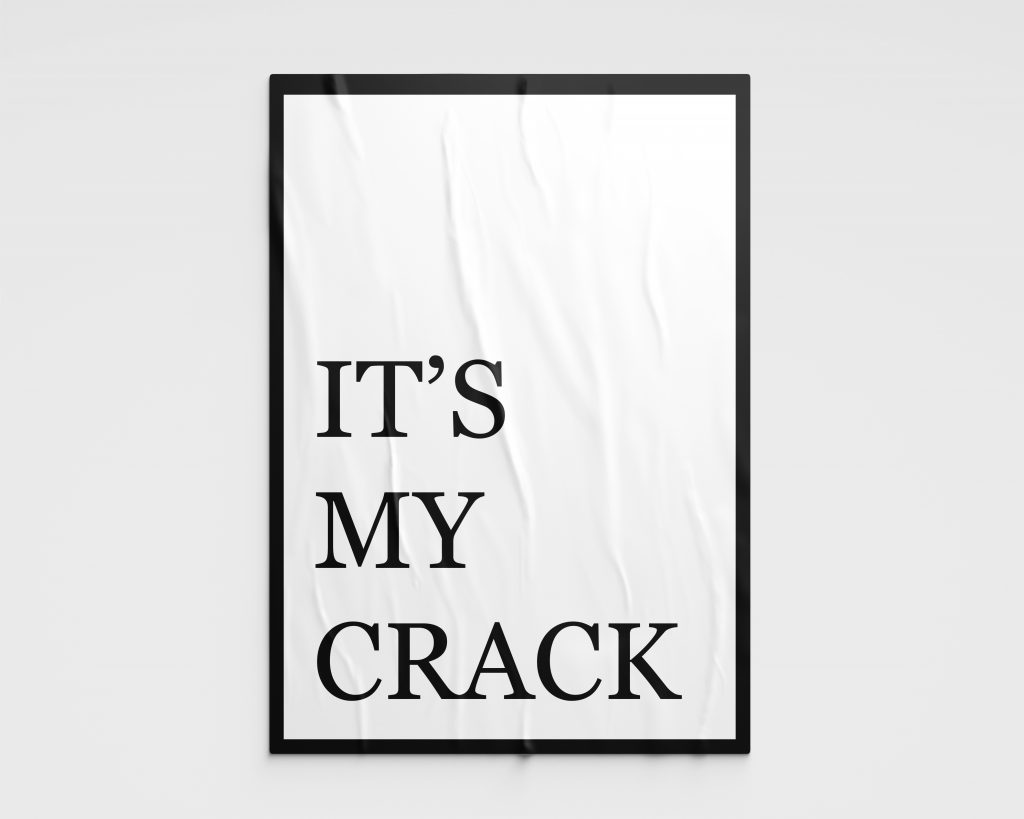
“Typography is painting with words.
That’s my biggest high.
It’s my crack.”
Paula Scher in Abstract: The Art of Design describes typography, her passion, as being her “Crack”. This resonated with me as Graphic Design to me is addictive, fulfilling and exciting.
Workshop Challenge
WHO AM I?
Hi, my name is Gary Philo. I graduated in 2007 from my local university. Jobs were sparse when I first entered the world of work and so I ended up taking a role in the local police force. I spent 7 years here before making a stand and leaving, starting again from the bottom, and going back to what I loved – design. I moved around a couple of print companies before re-joining the police in their communications department which I kept at for several years. With enough experience behind me I then found my dream job as a Graphic Designer at a local authority. I suppose my work history in public services has kind of defined me as a person and as a Graphic Designer. I like to serve the public. Inspire, encourage and amaze them.
WHAT DO I DO?
The project I am most proud of right now is a stretch of 185m designed hoardings which encircles a leisure centre build. I decided to highlight the history of the site and its importance to the local area. I researched the images and its story before and designing each panel. I also even managed the installation! Being a proud Great Yarmouth resident, the real reward was seeing people reading the panels and reminiscing about yester year. If I can make a positive impact on someone’s life through design, I’m a happy man!
WHERE AM I?
I was born in London but moved to Great Yarmouth was I was eight years old. The place means a lot to me. I grew up here, found love here, started my family here and now I work here. It’s a great place to live and work but in terms of design jobs and finding other creatives it can be a bit difficult. I am perched on the east coast of the Great Britain and have to travel for 30-40 minutes to get to the nearest city. I am hoping, with so many working from home and with the new practices brought about by Covid, that networking and design will take on a more digital approach.
WHY DESIGN?
Design is important to me because improves accessibility for everyone. I am the first to admit that a 200-page document in Word isn’t the most exciting or digestible thing to read. But a designed version will not only keep my interest, it will also help with understanding of the text, its intended tone and its goals. I love it when there is a ‘happy design accident’ but I also love it when a brand is carefully thought out, based on history / culture and resonates for years to come. Ultimately, design makes me proud, excited and determined and I know that it will always will be part of who I am and how I identify.
Quad triptych




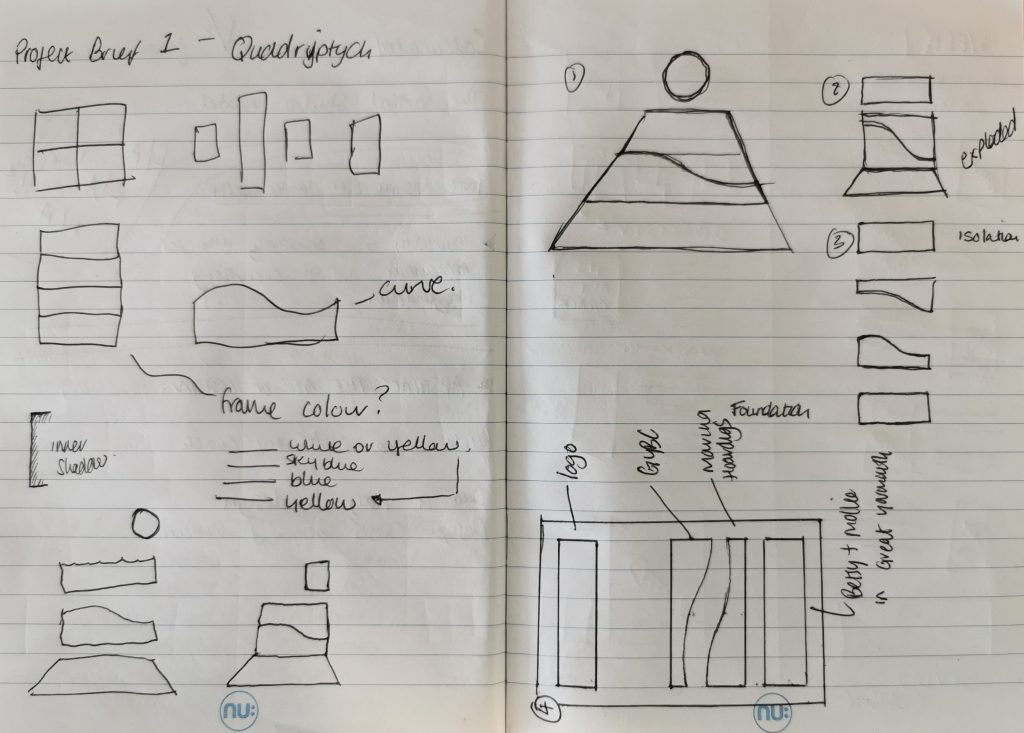

Top Panel
This is a logo of my surname which was created especially for this course. It is important to me because of its pronunciation. I hope by highlighting the ‘hi’ it will mean people pronounce it correctly. It is, of course, also a friendly way to say hello.
I have separated this panel from the next to highlight the isolation I feel in my current location and the lack of creatives in the immediate vicinity.
Panel Two
This is a photo of the Town Hall where I (usually) work. The logo is important to me as I recently helped them to rebrand and the heritage green is significant to the local area. I feel that this helps define who and where I am as it is a big part of my life.
Panel Three
One of my proudest moments was seeing this 185m designed hoardings being installed outside a leisure centre build. What makes me proudest, however, is not the design itself but instead the reaction from the local and visiting population who have now learnt something about Great Yarmouth’s interesting heritage.
Panel Four
My family is my foundation. Everything I do is for them and everything I am able to do is because of them. They support me in all that I do, and we are stronger together. They are at the bottom of this quad triptych to symbolise the strong footing they give me in my life.
Overall design
I hope the design of each panel gives you some idea of the area i live in. The bottom panel is a sandy colour to represent the beach. The next two panels are blue / green colours and with a wave design to represent the sea while the top panel is bright yellow to symbolise the sun.
Weekly reflection
This workshop has shown me all the things that influence my practice which I wasn’t aware of. It has reinforced my love for Graphic Design and actually made me think how much I take into consideration when designing.
The practitioner case studies were an invaluable part of this week’s studies. I have never worked in a traditional studio, so it was extremely enlightening to see how different types of agencies work. The most important part I have taken from this week is that most designers provide a ‘holistic communication solution’ which I am slowly learning to provide myself.
My quadriptych is a direct response to all that I have learned within this week’s lessons and shows my identity in 4 simple panels. It was a relatively quick and simple task, but I hope the evaluation of the practitioner case studies above has shown my thinking when pulling them all together. Personally, I feel the final piece came together quite quickly without much exploration, so I hope to provide some more rough sketches going forward through the upcoming weeks.
I wasn’t really sure how much work was required on the blog etc so the webinar on the first week was an eye-opener to say the least! Now I know what is required of me I feel a lot more confident and am ready for the next week to begin.
Overall, this has been an excellent start to my studies and has already made me learn a lot more about who I am and how I work. I hope this self-exploration continues as I feel that, by knowing myself better, I will be able to be the best designer I can.
References
BROOK, Tony and Adrian SHAUGHNESSY. 2009. Studio Culture. London: Unit Editions
YATES, Derek and Jessie PRICE. 2015. Communication Design: Insights from the Creative Industries. London: Fairchild Books
‘Intel Visual Life – Michael Wolff | Intel.’ 21AD. Available at:
https://www.youtube.com/watch?v=BTfAzjBTokc.
‘Abstract- The Art of Design Season 1 Episode 6- Paula Scher- Graphic Design.’ 21AD.
Available at: https://www.youtube.com/watch?v=0s71WGOU3wo.
‘Design Everywhere.’ n.d. [online]. Available at: http://designeverywhere.tumblr.com/.
‘Visuelle.’ n.d. [online]. Available at: http://visuelle.co.uk/
FedEx Logo. Available at: https://pixellogo.com/blogs/pixellogo-blog/fedex-logo-design-and-its-hidden-message [accessed 19/01/21]


Leave a Reply